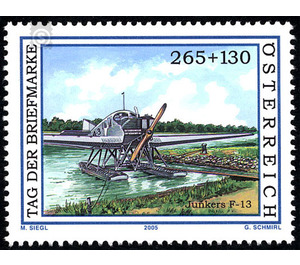day of the stamp - Austria / II. Republic of Austria 2005 - 265 Euro Cent
Theme: Science
| Country | Austria / II. Republic of Austria |
| Issue Date | 2005 |
| Face Value | 265.00 |
| Edition Issued | 720,000 |
| Printing Type | combination printing |
| Stamp Type | Semi-Postal |
| Item Type | Stamp |
| Chronological Issue Number | 1875 |
| Chronological Chapter | OOS-OE2 |
| SID | 540719 |
| In 48 Wishlists | |
The motif 2005: the Vienna-Budapest seaplane line and one of the Junkers F13 machines used on this route. After the successful success of the Austrian Army Aviation of 1918, the successful installation of the world's first international airmail service from Vienna via Krakow and Lviv to Kiev (Ukraine), interest in air traffic in Austria remains high. But at least a dozen attempts to found an airline fail because of the lack of capital, the lack of a domestic aircraft industry and the rejection of free competition for fear of fragmentation of the already small resources of now small Austria. In the spring of 1922, however, the era of civil aviation for Austria began, namely when the Vienna-Aspern airport was served by the "Compagnie Franco Roumaine de Navigation Aerienne" (CFRNA) with a biplane (F-ADCF) on schedule. The Austrian Air Transport Company (ÖLAG) officially takes its official start on May 3, 1923, when Dr. Ing. Bardas-Bardenau receives the authorization to set up an Austrian airline. The share capital amounts to one billion kroner, whereby the Junkers aircraft works with 49%, the Austrian railway transport authority (EVA) with 50% and Bardas Bardenau itself with 1%. With the arrival of the first Junkers F13 on the Danube Meadow at Jedlesee on May 14, 1923, the official flight operations of the ÖLAG start on the line "Vienna - Munich" (A-2, A-3). A few weeks later, on 16 July, a regular service along the Danube from Vienna to Budapest will be set up with Junkers F13, equipped with floats for this purpose. This is the first scheduled air traffic in Europe with seaplanes.


